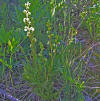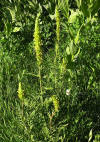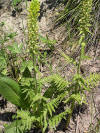
Pedicularis contorta
Marble Mts. Wilderness,
Lake of the Island, CA
July 2006 |

Pedicularis bracteosa
Marble Mts. Wilderness,
Lake of the Island, CA
July 2006
|

Pedicularis bracteosa
Southeastern ID
July 2005
|
| |

Pedicularis densiflora
Tehama Co., CA
SPJ-16223, Mar 2008 |

Pedicularis racemosa
Rocky Mts. Continental Divide. Wyoming.
Carbon Co.: Medicine Bow Natl. Forest near CO state line, along Hwy 70,
Battle Pass; 41Ί09'11.7", 106Ί5851.8, 3044 m. Spruce-fir forest with
Vaccinium understory. SPJ-16414, 05 Aug 2008
|
|
Mu P., X. Gao, Z. J.
Jia and R. L. Zheng. 2008. Natural antioxidant pedicularioside G inhibits
angiogenesis and tumourigenesis in vitro and in vivo. Basic Clin.
Pharmacol. Toxicol.102(1): 3034. Pedicularioside G is a new
compound of phenylpropanoid glycosides, isolated from Pedicularis
striata in our laboratory. Pedicularioside G inhibited two major
angiogenic responses, human umbilical vein endothelial cell proliferation
and migration, as well as neovascularization in a chicken embryo
chorioallantoic membrane model. In addition, pedicularioside G inhibited
human hepatoma cells proliferation and migration in vitro along with
transplanting tumour formation and growth in a chicken embryo
chorioallantoic membrane model. So pedicularioside G has anti-angiogenic,
antitumour growth, antimetastatic and antitumoural effects.
Pedicularioside G also remarkably reduced reactive oxygen species level in
both vein endothelial cells and hepatoma cells in a
concentration-dependent manner. These results suggest that the anti-angiogenic
and antitumoural effects of pedicularioside G might partially attribute to
its antioxidative activity.
Rui-Chuan C.,
S. Jin-Hua, O. Gao-Liang, C. Ke-Xia, L. Jin-Quan and X. Xiao-Guang.
2002. Induction of differentiation in human hepatocarcinoma cells by
isoverbascoside. Planta Med. 68(4): 370372. Isoverbascoside,
a phenylethanoid glycoside, was isolated from Chinese folk medicine herb
Pedicularis striata Pall. Here we report that isoverbascoside is
capable of inducing differentiation in human hepatocellular carcinoma (HCC)
cell line SMMC-7721. When treated with isoverbascoside, the proliferation
of SMMC-7721 cells was markedly inhibited in a dose- and time-dependent
manner, and the average cell population doubling time was delayed.
Exposure of cells to 20 micromol/l isoverbascoside led to the decline of
colony formation efficiency on soft agar, induced G0/G1 arresting, and
resulted in the decrease of gamma-glutamyltransferase (gamma-GT) activity
and the increase of tyrosine aminotransferase (TAT) activity, two marker
enzymes, respectively, representing HCC malignance and differentiation
stage. These results suggest that isoverbascoside possess the activity of
inducing differentiation in SMMC-7721 cells.
Yuan CS, Sun
XB, Zhao PH, Cao MA. 2007. Antibacterial constituents from Pedicularis
armata. J Asian Nat Prod Res. 9(7): 673677. A
new neolignan glycoside named armaoside (1), together with six known
compounds (2-7), have been isolated from the whole plant of Pedicularis
armata Maxim. The structure of 1 was elucidated as erythro-(7S,8R)-1-(4-O-beta-d-glucopyranosyl-3-methoxyphenyl)-2-[3,5-dimethoxyl-4-oxo-cinnamic
aldehyde]propane-1, 3-diol by spectroscopic and chemical methods. All
compounds were assayed against Bacillus subtilis, Escherichia coli,
and Staphylococcus aureus.
Zhang F, Jia Z, Deng
Z, Wei Y, Zheng R, Yu L. 2002. In vitro modulation of telomerase
activity, telomere length and cell cycle in MKN45 cells by verbascoside.
Planta Med. 68(2):115118. Screening of natural products with
anti-tumor activity as telomerase inhibitor is a new subject in the field
of tumor therapy. Using telomerase PCR ELISA, telomere DNA hybridization
and flow cytometry analysis, the effects of verbascoside, a
phenylpropanoid glucoside extracted from Pedicularis striata Pall,
on telomerase activity, telomere length and cell cycle of human gastric
carcinoma cells MKN45 was examined in vitro. After being treated with a 50
% inhibition concentration of verbascoside (17.8 microg/ml), telomerase
activity in the cells was significantly inhibited but not in the cellular
supernatant, the average telomere length became remarkably short, and the
sub-G0 /G1 peak and G2/M arrest were also displayed when compared to the
control cells. These results suggest that verbascoside mediated-cell
differentiation and apoptosis may be affected by telomere-telomerase-cell
cycle dependent modulation. Thus, the antitumor mechanism of verbascoside
is demonstrated once more by its inhibiting effect on telomerase activity
in tumor cells, and the telomerase assay may provide a valuable screening
method for antitumor activity of natural products.
|